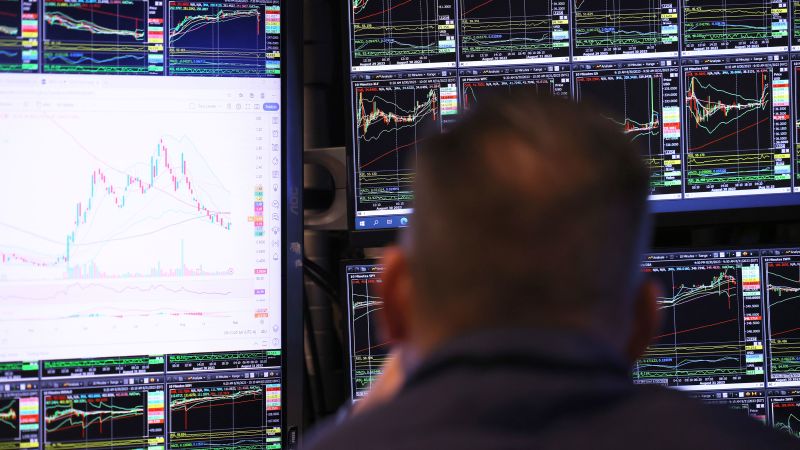A version of this story first appeared in CNN Business’ Before the Bell newsletter. Not a subscriber? You can sign up right here. You can listen to an audio version of the newsletter by clicking the same link.
Investors who missed out on this year’s unexpected rally seem to be dipping their toes back into the US stock market.
Global fund managers increased their exposure to US stocks this month by a record amount, according to Bank of America survey data going back to 1999. September also marked the first month global fund managers have had an outsized allocation in US equities since last August.
That suggests that investors who watched equities steadily climb higher this year are starting to take their cash off the sidelines and put it into the stock market, some investors say.
The benchmark S&P 500 index has climbed roughly 15% this year, defying Wall Street skeptics’ expectations that the market would sink as the Federal Reserve continued to hike interest rates to tamp down inflation.
That’s caused some investors to come down with a classic case of fear-of-missing-out, says Saira Malik, chief investment officer at Nuveen. The rally’s late summer stall-out, particularly in the mega-cap technology names that have led the stock surge this year, has created an opportunity for investors to buy the dip.
The S&P 500 has fallen 2.4% so far in September after logging a 1.8% loss in August, its second losing month this year. Tech bigwig Nvidia has tumbled roughly 14% this month, Apple declined 7% and Microsoft slipped 2%.
Wall Street also expects that the Fed is nearing the end of its rate-hiking cycle. The data-dependent central bank held rates steady on Wednesday and signaled that it could hike rates once more this year. Traders largely expect the Fed to hold rates steady in November, though they remain split on whether the central bank will hike or hit the pause button again in December, according to the CME FedWatch Tool.
The expectation that the Fed will soon finish hiking rates has in turn brightened the outlook for a possible soft landing, a scenario in which inflation comes down to the central bank’s 2% target without causing a sharp economic downturn, according to Malik. Both spending and the job market have stayed resilient this year, playing key roles in supporting the economy through the Fed’s arduous rate increases.
“[Investors] were holding their cash saying, ‘okay, when the recession comes, I’ll put my money back into the market.’ Instead, we have not seen a recession,” said Malik.
Still, bond yields rose to their highest level since 2007 this week, as investors bet that the central bank will keep rates higher for longer. That could continue putting pressure on stocks, along with spiking oil prices that edged above $90 a barrel last week for the first time in nearly a year.
If those assets keep offering higher returns, risk-averse investors might continue to seek them out as safer investments over stocks — particularly government-backed bonds.
Higher-for-longer rates could also put pressure on tech stocks that have led this year’s surge.
“Heading into the fourth quarter with rate expectations remaining elevated, we are more than likely in for a choppy end of the year,” said Alex McGrath, chief investment officer at NorthEnd Private Wealth.
You’re about to see people in public tapping two fingers together in the air, my colleague Samantha Kelly reports.
Over the past few days, she’s been taking phone calls, playing music and scrolling through widgets on the new Apple Watch Series 9 without ever touching the device. She’s used it to silence her watch’s alarm in the morning, stop timers and open a notification while carrying too many bags.
It may sound like a gimmick — and it most certainly feels strange to do it in public — but considering the small size of the Apple Watch screen, the tool offers an effective hands-free way to interact with the device, Sam reports.
Apple’s latest lineup of smartwatches, the Watch Series 9 and high-end Ultra 2, feature a new gesture tool called Double Tap, allowing users to tap their index finger and thumb together twice, to control the device. It can also scroll through widgets, much like turning the digital crown.
Read more here.
Elon Musk’s controversial biotechnology startup Neuralink opened up recruitment for its first human clinical trial Tuesday, according to a company blog, reports my colleague Jennifer Korn.
After receiving approval from an independent review board, Neuralink is set to begin offering brain implants to paralysis patients as part of the PRIME Study, the company said. PRIME, short for Precise Robotically Implanted Brain-Computer Interface, is being carried out to evaluate both the safety and functionality of the implant.
Trial patients will have a chip surgically placed in the part of the brain that controls the intention to move. The chip, installed by a robot, will then record and send brain signals to an app, with the initial goal being “to grant people the ability to control a computer cursor or keyboard using their thoughts alone,” the company wrote.
Read more here.
Read the full article here











Leave a Reply